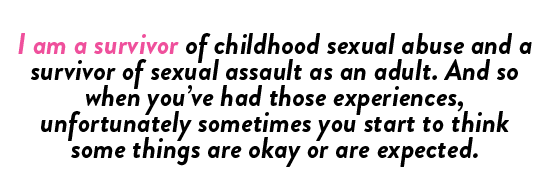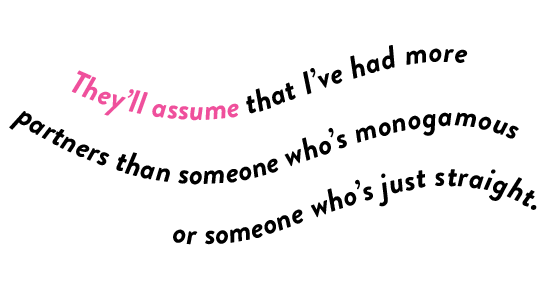Healthcare Barriers for the LGBTQ2S+ Community

In Oklahoma, the LGBTQ2S+ (lesbian, gay, bisexual, transgender, queer/questioning, two-spirit) population, estimated at 138,000, [1] faces unique challenges related to health care. The community is diverse in terms of race, religion, ethnicity, nationality, and socioeconomic class.
They experience health disparities, such as lower rates of health insurance and higher use of emergency rooms for treatment, [2] that largely stem from their societal marginalization and the denial of their rights. Other barriers that lead to these disparities include a shortage of health care providers who are trained and culturally aware of LGBTQ2S+ health and a lack of clinical research focused on LGBTQ2S+ health-related issues. [3] Many individuals in the LGBTQ2S+ community delay getting medical care or do not receive appropriate health care due to fear of or previous experiences with discrimination, harassment, stigma, violence, and institutional biases. [4] Delays in seeking care can affect health outcomes and exacerbate existing conditions.
The Prism Project, a needs assessment among Tulsa’s LGBTQ2S+ community, found that one in four reported not having a primary care provider, including 34.8% of Latinx and 30% of American Indian respondents. [5] Moreover, although the uninsured rate was low within the sample (8.6%), the rate remained high among Latinx (26.1%) and black/African-American (21.1%) respondents. [6] Of those without a primary care provider, 27.8% report they do not seek healthcare because they can’t afford it. [7]
According to the Kaiser Family Foundation, LGBTQ2S+ individuals are more likely to report that providers do not believe they are telling the truth, assume something about them without asking, and suggest that they could personally be responsible for their health issues at higher rates than non-LGBTQ2S+ people. [8] In general, these issues were more prevalent among LGBTQ2S+ women and people assigned female at birth who are more likely to receive poor treatment as a result of their gender. [9] Subsequently, they are also more likely to encounter conversations about their sexual history, HIV and other STIs with medical providers. [10]
Section 1557 of the Affordable Care Act prohibits discrimination based on race, color, national origin, sex, age, and disability in health programs and activities receiving federal financial assistance. [11] Yet, Oklahoma’s policy related to LGBTQ2S+ furthers the marginalization that this population faces. The state has not enacted key non-discrimination laws, such as private health insurance nondiscrimination laws, and a ban on health insurance providers excluding coverage for transgender-specific care. [12]
Previously, Oklahoma lawmakers introduced bills that would affect this community. The past legislative session saw the introduction of a new bill that would make it a felony to provide gender-affirming medical treatment, other than counseling, to anyone under the age of 21. Such treatment can alleviate gender dysphoria and postpone puberty to give children time to explore and understand their gender identity. The bill would punish doctors, parents, and even children themselves with penalties of up to life imprisonment. [13]
Barriers to healthcare access can cause immediate and long-term consequences for this population. Despite improving at the federal level, efforts to improve LGBTQ2S+ health lag as data collection is not standard. [14] This lack of research and education around LGBTQ2S+ health affects the drafting of policy and training of health care providers. Collecting data that captures the experiences of this community is important to further health equity and access. Efforts to improve health outcomes for this population includes collecting sexual orientation and gender identity data in health-related surveys and health records, providing training to medical students to increase culturally competent care, and providing supportive social services that center cultural competency. [15]
People with uteri, individuals assigned female at birth, and self-identifying women within the community face specific barriers to care. In the following narratives, women of the LGBTQ2S+ community share their experiences of accessing health care and the barriers they encounter as they navigate a health care system that does not always work to fully understand every aspect of who they are. They bare truth to their experiences of not being believed, of providers assuming things about them, and the labor of having to advocate for themselves knowing discrimination is still eminent. Despite these interactions, they speak with hope and resilience as they continue to challenge the constraints of what defines womanhood––dreaming of an Oklahoma that understands the nuances of the LGBTQ2S+ community.
Healthcare Barriers for the LGBTQ2S+ Community

In Oklahoma, the LGBTQ2S+ (lesbian, gay, bisexual, transgender, queer/questioning, two-spirit) population, estimated at 138,000, [1] faces unique challenges related to health care. The community is diverse in terms of race, religion, ethnicity, nationality, and socioeconomic class.
They experience health disparities, such as lower rates of health insurance and higher use of emergency rooms for treatment, [2] that largely stem from their societal marginalization and the denial of their rights. Other barriers that lead to these disparities include a shortage of health care providers who are trained and culturally aware of LGBTQ2S+ health and a lack of clinical research focused on LGBTQ2S+ health-related issues. [3] Many individuals in the LGBTQ2S+ community delay getting medical care or do not receive appropriate health care due to fear of or previous experiences with discrimination, harassment, stigma, violence, and institutional biases. [4] Delays in seeking care can affect health outcomes and exacerbate existing conditions.
The Prism Project, a needs assessment among Tulsa’s LGBTQ2S+ community, found that one in four reported not having a primary care provider, including 34.8% of Latinx and 30% of American Indian respondents. [5] Moreover, although the uninsured rate was low within the sample (8.6%), the rate remained high among Latinx (26.1%) and black/African-American (21.1%) respondents. [6] Of those without a primary care provider, 27.8% report they do not seek healthcare because they can’t afford it. [7]
According to the Kaiser Family Foundation, LGBTQ2S+ individuals are more likely to report that providers do not believe they are telling the truth, assume something about them without asking, and suggest that they could personally be responsible for their health issues at higher rates than non-LGBTQ2S+ people. [8] In general, these issues were more prevalent among LGBTQ2S+ women and people assigned female at birth who are more likely to receive poor treatment as a result of their gender. [9] Subsequently, they are also more likely to encounter conversations about their sexual history, HIV and other STIs with medical providers. [10]
Section 1557 of the Affordable Care Act prohibits discrimination based on race, color, national origin, sex, age, and disability in health programs and activities receiving federal financial assistance. [11] Yet, Oklahoma’s policy related to LGBTQ2S+ furthers the marginalization that this population faces. The state has not enacted key non-discrimination laws, such as private health insurance nondiscrimination laws, and a ban on health insurance providers excluding coverage for transgender-specific care. [12]
Previously, Oklahoma lawmakers introduced bills that would affect this community. The past legislative session saw the introduction of a new bill that would make it a felony to provide gender-affirming medical treatment, other than counseling, to anyone under the age of 21. Such treatment can alleviate gender dysphoria and postpone puberty to give children time to explore and understand their gender identity. The bill would punish doctors, parents, and even children themselves with penalties of up to life imprisonment. [13]
Barriers to healthcare access can cause immediate and long-term consequences for this population. Despite improving at the federal level, efforts to improve LGBTQ2S+ health lag as data collection is not standard. [14] This lack of research and education around LGBTQ2S+ health affects the drafting of policy and training of health care providers. Collecting data that captures the experiences of this community is important to further health equity and access. Efforts to improve health outcomes for this population includes collecting sexual orientation and gender identity data in health-related surveys and health records, providing training to medical students to increase culturally competent care, and providing supportive social services that center cultural competency. [15]
People with uteri, individuals assigned female at birth, and self-identifying women within the community face specific barriers to care. In the following narratives, women of the LGBTQ2S+ community share their experiences of accessing health care and the barriers they encounter as they navigate a health care system that does not always work to fully understand every aspect of who they are. They bare truth to their experiences of not being believed, of providers assuming things about them, and the labor of having to advocate for themselves knowing discrimination is still eminent. Despite these interactions, they speak with hope and resilience as they continue to challenge the constraints of what defines womanhood––dreaming of an Oklahoma that understands the nuances of the LGBTQ2S+ community.
Narrative #1
“Living in Two Worlds”
I identify as Two-Spirit, gender non-conforming, and transgender. A lot of people don’t understand why I identify in that manner, so I’d like to explain. I am Choctaw, Cherokee, and Seminole, and as a Native person, I identify as Two-Spirit. A Two-Spirit person— their gender and sexual orientation is, for lack of a better word, typical or normal to them. So for me, as a Native person, I feel congruent in the body that I was born into.
But as the white part of me or the Western part of me, I do not feel congruent in my body. And so, I include in my identity to people, that I’m gender non-conforming; I don’t conform to the general norms that society has put on gender. And I identify as transgender because I don’t feel congruent in how I identify. I identify with both genders, and sometimes no gender at all.

Experiences with Healthcare
I went as a gender non-conforming person to get breast reduction surgery. I went to a surgeon to get an assessment. And he was extremely discriminating. He asked me, “What do you do for a living?”
And I said, “I am a gender therapist, and I own a gender diverse and LGBTQ community resource center.”
He said, “Are you one of them?”
I said, “Am I one of them . . . do you mean am I gender diverse and LGBT?”
He said, “Yes.”
I said, “Yes I am.”
And he said, “Do you have HIV?”
I said, “No…”
He said, “What drugs do you use?”
I said, “I don’t use drugs.”
He said, “Are you sure you don’t use drugs?”
And I said, “Yes, I don’t use drugs.”
And he said, ”How much alcohol do you drink?”
And I said, “I drink socially. I drink maybe once or twice a month at fundraisers.”
And he goes, “Hm.” Before even examining me, he said, “I think you’re overweight. I don’t think you’ll qualify for a reduction. But I’ll go ahead and do your examination.”
He was extremely judgmental, and had already put me in a category. I should have walked out, but the reason why I stayed was I wanted to see how bad he would be. Because I send a lot of people for top surgery. And this is not a surgeon I would ever recommend to anyone. And he’s supposedly one of the leading surgeons in Oklahoma City for plastic surgery.
Besides being discriminating, and trying to be a barrier for my medical care, and despite me telling him I had a heart condition, that I had osteoarthritis in my back and neck, and that I had medical reasons for getting a breast reduction, none of that mattered to him.
But that’s minor compared to the stories that I get from our trans folks and our LGB folks when they try to access care. I just think it’s so unbelievable that people can be so blatant when they take a Hippocratic oath to provide healthcare to everyone. It’s really sad that people are that way.
Societal Norms Around Gender
Society assumes what your gender is from your outward expression. That has been really challenging for me, how to live within that space. Native people talk about how Two-Spirit people live in both worlds. And sometimes living in two worlds is really challenging.
Sexual harassment is something that a lot of people don’t talk about for people that are AFAB [assigned female at birth], and it becomes normalized for people. I am a survivor of childhood sexual abuse and a survivor of sexual assault as an adult. And so when you’ve had those experiences, unfortunately sometimes you start to think some things are okay or are expected. You don’t realize, “Oh, that’s not how everyone’s treated.”
I was in college and had a professor that I feel made advances towards me. And I didn’t do anything about it because of the power differential. And I know lots of people that have experienced those things, too. In fact, I help people at the center now to file lawsuits against professors that do things like that. But when I went to school, I didn’t know that I had the power to do something about it. I felt like I was powerless.
Stigma of Birth Control
There’s a stigma that if you are accessing birth control and you’re not married, then you’re probably being promiscuous. Especially in the Midwest, [there’s a perception that] women or people with a uterus only need to be having sex with their husbands or their spouses. There’s not the same stereotype for persons that are born typically male. So women or persons that are assigned female are shamed or guilted and they carry that guilt or shame into the proverbial bedroom with them. And that impacts their sexual satisfaction sometimes.

Policy Visions
We need to prevent conversion therapy for our kiddos. We see so many people who have experienced conversion therapy and the damage that it does to them. Parents think that they have good intentions by sending their kids to these special camps, these church counseling programs. They physically abuse these children and psychologically abuse them. It’s horrible. Those things need to change.
We just had a bill made against our trans children, [not allowing them] to play sports related to their gender or their sexual orientation. That needs to be changed.
Right now there are no laws related to domestic violence or sexual assault for our trans folks or our LGBT folks. If they experience acts of violence towards them, if someone gets strangled, it’s not like it is for a cisgender person. I don’t think people realize those bills do not protect our trans and LGBT folks. Those laws need to protect them as well.
People need to feel like they still have control over their bodies and what happens with their body. [They need to] feel empowered to accomplish things that they set out for, [and] get the support that they need from the community.

Narrative #2
"I Knew My Own Body”
I identify as she/her and I identify as pansexual and polyamorous. I’m straight passing, so I don’t really deal with a lot of things that other people of the LGBTQ community do. But, yeah, I mean, it’s definitely different growing up here, being born here.
Barriers: The Cost of Health Care
I think that the biggest one is money and not having it and not having anyone who cares. As far as health care goes, I need to get health care. I mean, I’ve never been to the gynecologist, which is something that I would like to do. I just don’t have the funds. So let’s say there’s a lack of oversight in general where if you miss out on getting things done for your health, there is no one here like checking on you or making sure it gets done.
I need to get some stuff done as far as testing and appointments. But I don’t have insurance right now, so I’m not really able to do a lot of that. I have an autoimmune disease that I’ve been needing to check levels for, but I started my own business in 2018 and when I did that, I was only able to afford the monthly premium of my insurance, and I was never able to afford the labs. So I’m once again kind of stuck. I don’t have insurance anymore.
So I haven’t been to a doctor since 2018. I went to urgent care a few weeks ago because I wasn’t feeling well. But I had, I guess it ended up costing me about 300 dollars, and they wouldn’t test me for anything. I begged them for a strep test and a flu test, but they refused testing for covid. They just wanted to charge me the money and then told me to, you know, go home. So I don’t go to the doctor, not because I don’t want to. It’s just that I just happened to be in a rough spot for, like, the last three years.

Barriers: Layers to Seeking Medical Resources
I’m straight passing, so unless I’m getting tested, I feel like I don’t get discriminated against. If I am––I’m getting an STD test, then if I’m getting it with the county, they will. If I say like I’m bisexual, pansexual, any of that, they will ask me more about like how many partners I’ve had. They’ll assume that I’ve had more partners than someone who’s monogamous or someone who’s just straight. But as far as regular health, the only thing I have to deal with as a woman is not being taken seriously. Like whenever I got my autoimmune disease, I initially went to the doctors because my first symptoms were like depression and sleeping a lot. And I had to go to like ten different doctors to get my thyroid tested because all the doctors just said, ‘you’re tired, sleep more’. But I knew my own body, and I knew that I was sleeping more than I should have been. And so I did take finding a doctor who was female to take me seriously. I mean, all the other doctors I’ve gone to before that were men.
I can’t even imagine what non-binary individuals go through, you know, or trans people. I am just very surface level as far as any of that is concerned. I don’t have to deal with half the stuff other people do. And like with the gyno [gynecologist], I’m sure that’s difficult for people who are non-binary as well, because they probably go into a spot and it’s filled with––I’m sure it’s filled with all sorts of like feminine looking things. But I mean, I wouldn’t know. I’ve never been able to go to one.
Policy Action
I know, like I’ve been trying to get tested for STDs lately, and unless I go down to Norman, I’m not able to get it with the county because you’re supposed to call like 7:00 a.m. and they have like five spots that they fill. And right now I’m working about 70 hours, so I can only really do it during a lunch break. And that’s if I can get back in time. So I’m working all the time and there’s no way to do it with the county and schedule it out. Like you have to call at 7:00 a.m., then go that same day. So I’d say maybe more open and free testing for people. I think that would be beneficial to the community because it’s something that I want to do. I know other people wouldn’t even like––they’re going to need it to be a lot more accessible for them to do it. And that’s important. Like, if you don’t make it easy for people, they’re not going to want to and they’re just going to either lie or rationalize it in themselves and think, ‘well, I’ll do it after this, this hook up or after this partner.’ Yeah, we don’t really have any sort of public health awareness about any of those things. Really.

So yeah, STD testing, and then maybe just people with uteri having another option for abortions, because I’ve never had one, but I have a lot of friends who have had, who have experienced it, and they will talk about how there are only two choices. And the problem is that if they have to get a second one they are too embarrassed to go back. And then that leaves the one other option. But the other one that I’ve heard of in Oklahoma City, I’ve heard that it’s just not as clean and not as nice. And so they like the Norman one better, but they feel like they’re going to get judged by the Norman facility. So, yeah, I think that that would help everybody. And I again, don’t have that experience personally, but just hearing about it makes me feel for people because I could very well go through that soon and know exactly what it’s like.
Visions for the Future
Well, I mean, I know I feel pretty bogged down and again, and I don’t really want to deal with half of the stuff other people do. So I see some sort of revolution in the future, whether it’s medical or all encompassing with society. I just kind of see it all hitting a tipping point. And I think that that’s––there’s going to be a lot of loss before it gets better. But I see tensions rising in all sorts of ways and getting that basic need of medical care is one of them.
I mean, it’d be really cool if there were different institutions that were put in place or just different safe houses. I don’t know. I mean, in Oklahoma, we don’t really have needle exchanges and safe houses for people. We don’t really even have anything like that. So we’re so far behind as far as how to care for someone without expecting something back. I just think that we’re really far behind. So everyone’s just––everyone’s needs are not being met on every level.
Takeaway Thoughts
I don’t see any push from the top, only if it affects the workforce. I only see positive change happening if it’s from a grassroots level, because the only concern from our leadership right now seems to be economy based and workforce based. So there are you know, if there is something that affects money, then I think that there might be change. But otherwise, I think it’s going to have to come from within and come from the grassroots field.

Organization Spotlight: Freedom Oklahoma
Freedom Oklahoma works across the state to create an Oklahoma where all 2SLGBTQ+ folks, inclusive of their gender identity, gender expression, and/or sexuality, have the safety to thrive.
1 “Oklahoma’s Equality Profile,” Movement Advancement Project, n.d., https://www.lgbtmap.org/equality-maps/profile_state/OK.
2 “LGBTQ+ Health Disparities,” Cigna, May 2021, https://www.cigna.com/individuals-families/health-wellness/lgbt-disparities.
3 “Lesbian, Gay, Bisexual, and Transgender Health,” Healthy People 2020, n.d., https://www.healthypeople.gov/2020/topics-objectives/ topic/lesbian-gay-bisexual-and-transgender-health#:~:text=Research%20suggests%20that%20LGBT%20individuals,%2C2%2C%20 3%20and%20suicide.
4 “LGBTQ+ Health Disparities,” Cigna, May 2021, https://www.cigna.com/individuals-families/health-wellness/lgbt-disparities.
5 E.D.E. Nay, “The Prism Project: Tulsa’s Sexual and Gender Minority Needs Report” (Tulsa Reaches Out, Hope Research Center, 2019), link.ou.edu/tulsa-lgbtq.
6 Ibid
7 Ibid
8 Lindsey Dawson et al., “LGBT+ People’s Health and Experiences Accessing Care ,” KFF, July 22, 2021, https://www.kff.org/report- section/lgbt-peoples-health-and-experiences-accessing-care-report/.
9 Ibid
10 Ibid
11 “Section 1557 of the Patient Protection and Affordable Care Act,” HHS.gov (US Department of Health and Human Services, n.d.), https://www.hhs.gov/civil-rights/for-individuals/section-1557/index.html.
12 “Oklahoma’s Equality Profile,” Movement Advancement Project, n.d., https://www.lgbtmap.org/equality-maps/profile_state/OK.
13 Ryan Thoreson, “Oklahoma Wants to Make Gender-Affirming Care a Crime,” Human Rights Watch, January 26, 2021, https://www. hrw.org/news/2021/01/26/oklahoma-wants-make-gender-affirming-care-crime#.
14 Lindsey Dawson et al., “LGBT+ People’s Health and Experiences Accessing Care ,” KFF, July 22, 2021, https://www.kff.org/report- section/lgbt-peoples-health-and-experiences-accessing-care-report/.
15 “Lesbian, Gay, Bisexual, and Transgender Health,” Healthy People 2020, n.d., https://www.healthypeople.gov/2020/topics-objectives/ topic/lesbian-gay-bisexual-and-transgender-health#:~:text=Research%20suggests%20that%20LGBT%20individuals,%2C2%2C%20 3%20and%20suicide.



